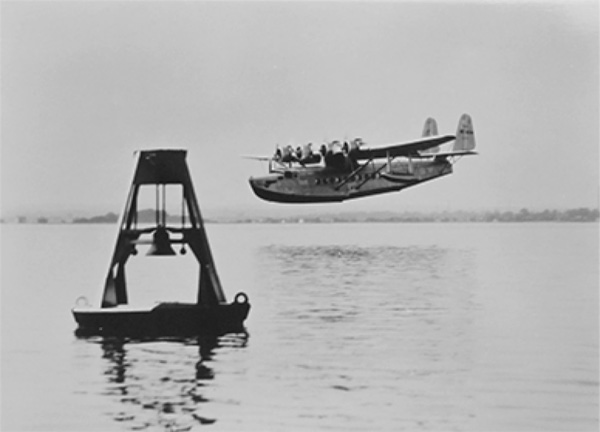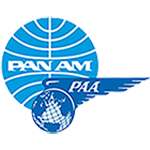MARCH 1934
“New Bird Lifts Off”

Photo: Sikorsky S-42 powered by Hornet Engines (PAHF collection).
It’s a specific world where six-hundred seconds of flight constitutes “success” (the Wright brother’s first 1903 flight 31 lasted 12 seconds) but on Thursday morning, March 29, 1934, Sikorsky Aircraft Corporation’s chief test pilot, Boris Sergievsky, and two mechanics, powered up the company’s newest aircraft, the Sikorsky S-42, and lifted off of Long Island Sound abreast the company’s Bridgeport, Connecticut base for a first-flight of an over-the-technological-edge seaplane designed to meet the companies’ most-important customer, Pan American Airways, Inc.’s demands.
Following an eight-second lift off, Sergievsky kept the untested four-engine aircraft aloft for ten minutes: aboard, these ten minutes probably seemed an eternity as he and two flight mechanics asked, “Will this $242,000 (approximately $5,500,000 in 2024) thing fly?”
With their first life-or-death fears removed, the three-person crew returned to the air for another ten-minute flight, then taxied the S-42 returned to the Sikorsky shop for a complete tear-down and assessment before required maneuverability and stability test flights on the next calm-water, low-wind, no-ice day.
That opportunity arrived the next week and this time the S-42 carried seven persons, including its designer Igor Sikorsky and H.A. Franchement, Pan American Airways Aircraft Engineer.
Through the aircraft’s month-long test period (an unfathomably short test window today) the initial S-42 set multiple world altitude, distance, and load records, due, in part, to its many technological innovations: “large wing flaps…flush riveting, engine synchronization, propeller brakes, and automatic carburetors.”
Sikorsky delivered the first S-42 aircraft, christened “Brazilian Clipper,” to Pan American Airways on May 6, 1934 and it remained in the company’s inventory for 12 years, outlasting all of its nine sister ships.
Sources:
Davies. R.E.G., “Pan Am: An Airline and its Aircraft,” Orion Books, 1987, p. 37.
“Giant Clipper Makes First Test Flight,” Pan American Air Ways, Vol. 5, No. 2 (March 1934), p. 1.
“First Lady Flies South”
 Photo: First Lady Eleanor Roosevelt ready to embark Pan American Airways' clipper to visit Puerto Rico, 1934-03-06 by Gleason Romer from Helen Muir Florida Collection. Special Collections and Archives. Miami-Dade Public Library System. https://cdm17273.contentdm.oclc.org/digital/collection/p17273coll3/id/15428/rec/17
Photo: First Lady Eleanor Roosevelt ready to embark Pan American Airways' clipper to visit Puerto Rico, 1934-03-06 by Gleason Romer from Helen Muir Florida Collection. Special Collections and Archives. Miami-Dade Public Library System. https://cdm17273.contentdm.oclc.org/digital/collection/p17273coll3/id/15428/rec/17
Early Tuesday, March 6, 1934, Miami’s newspaper reporter and photographer corps trailed passengers exiting the New York/Washington-Miami overnight train, focused on a group walking toward the “Aerocar,” heading to Pan American Airways’ Dinner Key base. There, as Eleanor Roosevelt boarded the 8:00 a.m. outbound Sikorsky S-40 “Clipper” and turned to allow the assembled photographers to take a picture of her holding a large bouquet of local flowers, she became the first First Lady of the United States to fly internationally.
Taking off, she began a twelve-day trip of Cuba and Uncle Sam’s possessions in the West Indies ( Puerto Rico, St. Thomas, St. Croix), touted as “a first-hand investigation of living and working conditions” in that region.
Pan Am personnel flew Eleanor along its regularly scheduled service to San Juan that Tuesday, stopping at Nuevitas, Cuba, to refuel and staying overnight in Port au Prince, Haiti. Then she flew on to San Juan, Puerto Rico, and boarded a chartered Pan Am Consolidated Commodore seaplane to continue on to a two-day visit to St. Thomas and St. Croix.
By noon at the end of her tour March 17th, a crowd had assembled to greet the First Lady on Sikorsky S-40, “Caribbean Clipper,” under the command of Pan Am veteran pilot Carl Dewey, as he landed the 38-seat craft at Dinner Key.
Once at the dock, the First Lady exited the aircraft, took questions from reporters, posed for pictures, signed autographs, then exited to catch her train back to Washington where she and her team would brief President Roosevelt on their inspection-tour findings.
Source: “First Lady of United States Uses Airline,” Pan American Air Ways, Vol. 5, No. 2 (March 1934), p. 1.

